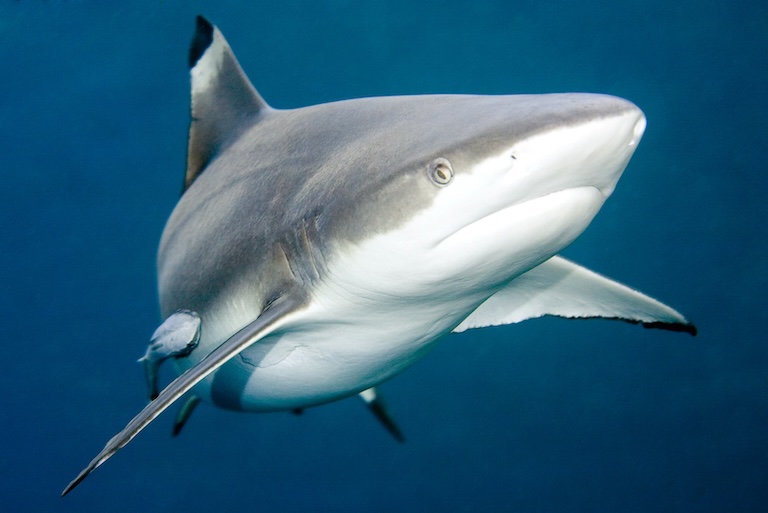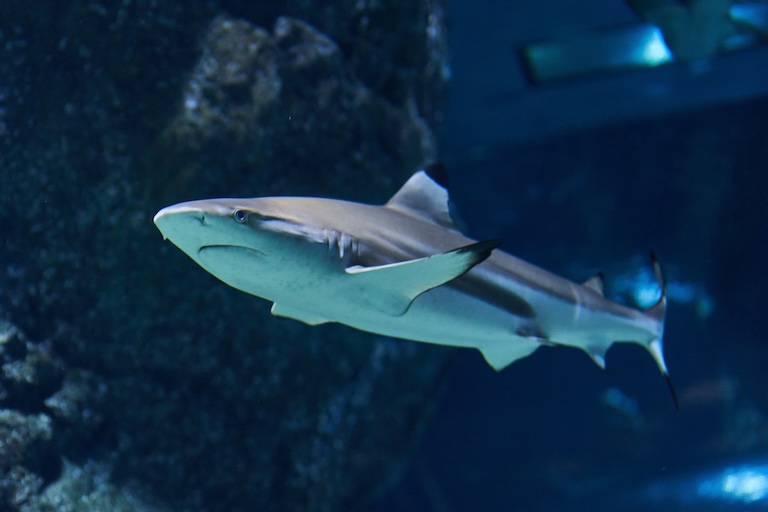Blacktip Reef Shark Profile
Every year, somewhere under the sea, there’s a pageant held by the Poseidon Corporation for the best-looking, most athletic, most stylish and overall coolest animal in the ocean.
Categories are varied, but evolution is pretty slow, so every year it’s the same winners in each category. Mermaids win both the “Best Breasts on a Fish” and “Best Tail on a Woman” categories. Bowheads win the “Largest Mouth”, and every year, without fail, black-tip reef sharks win “Best Looking Shark”.

Blacktip Reef Shark Facts Overview
| Habitat: | Reefs |
| Location: | Indo-Pacific |
| Lifespan: | Up to 25 years in captivity |
| Size: | Under 2 meters long |
| Weight: | Up to 20kg |
| Colour: | Grey, with black tips on the fins |
| Diet: | Fish, cephalopods, crustaceans, other sharks |
| Predators: | Groupers, other sharks |
| Top Speed: | 23km/h (14 mph) |
| No. of Species: | 1 |
| Conservation Status: | Vulnerable (IUCN) |
Black tips are the best of the best when it comes to sleek, powerful sharks, The only thing holding them back is their relatively diminutive size and the fact they have nipples on their noses.
They are one of the few animals whose Latin name is even cooler than their common name, but even with all this grace and privilege, they’re still not entirely confident and tend to be shy, humble animals.
Interesting Blacktip Reef Shark Facts
1. They’re probably the best sharks
Blacktips are requiem sharks, and as we all know by now, requiem sharks are the glamour models of the shark world already, but of the 12 genera of incredible sharks in this order, the Carcharhinus genus has to be the elite league.
This genus is home to the silky, copper, dusky, graceful and all the other sharks the seven dwarfs wished they were (let’s ignore bignose and pigeye for now).
And even among the best of the best, the blacktip stands out. They are absolutely stunning animals, classically powerful, intelligent and sleek, yet generally small and docile enough to get close to safely.
Even though these are not heavyweights of the order, in the reef, they’re usually at the top of the food chain and put significant selective pressure on all kinds of prey including both large and small fish, cephalopods and crustaceans.
2. Black wing
The suffix -ptera (or the prefix Ptera-), comes up a lot in biological names.
The flower species that lends its name to Addis Ababa in Ethiopia is macroptera which means “big wing”, and refers to its large yellow petals. Pteranodon translates to “Winged no-teeth”, and Pterosaur means “Winged lizard”. The species name of the incredible Dipteran (two-winged) insect Drosophila melanogaster translates to “black belly”.
And so we can extrapolate from all this that the blacktip reef shark’s species name, melanoptera translates to “Black wing”, which is perhaps the coolest name for a shark that anyone could possibly have come up with.

3. They’re nervous
The closest relative to the blacktip appears to be the Nervous shark, C. cautus, whose Latin and common name refers to its tendency to overthink things and get itself into a bit of a tizzy.
Likewise, the blacktip is a timid animal, and while it’s usually the boss of the reef, it does still have a lot of enemies to watch out for, especially when it’s young. It’s known to be shy and to take a while to warm up to divers, if at all.
It’s a generally skittish shark that needs to keep moving to survive. 1
4. They’re ram ventilators
There’s a common myth that a shark has to keep moving to breathe. It’s only half a myth, though. The majority of sharks breathe like bony fish, by puffing their cheeks out and blowing oxygenated water over their gills. This is called buccal pumping, and it’s why your goldfish looks like he’s saying “Bob” all the time.
Most sharks are fine with this, but others, for some reason, just can’t do it. So, to keep that water flowing over the gills, they have to keep swimming into it. This is called ram ventilation and it’s very similar to how jet engines have air intakes to supply them with oxygen while they’re moving.
These are called “obligate ram ventilators”, meaning they don’t have a choice, they have to swim to breathe.
5. They have nose nipples
Even the best-looking sharks have something that they’re insecure about, and in this one, it’s a lobe of skin on their nostrils.
They’re said to be nipple-like, though this might say more about what’s on the author’s mind than the shark itself. Each nostril has a flap of skin that forms a lobe over it, and these are commonly referred to in descriptions of the shark, while very little is said about what they’re for.
Ultimately, they’re characteristic of the species and can be used to tell the blacktip apart from similar species like the closely related graceful shark, which sometimes also has black fins.
No wonder it’s shy. 2

6. They’re ankle-biters
Since this shark hates attention from people, the only time it’s any danger is either when there’s a bit of a feeding frenzy going on from divers chumming the waters, or when people are walking in the shallows and their ankles look a bit like a confused squid.
Bites do occur, but they’re rare, and this shark isn’t really big enough, nor does it have the teeth to cause a significant amount of damage. Blacktips represent 29% of bites in Florida, though there’s so much chicken grease on a lot of those ankles that it’s hard to call them unprovoked attacks. 3
7. Habitat quality is a concern
This is a reef specialist, which means if you take away the reef it will need to go back to school. And unfortunately, reefs are degrading all over the world.
Climate change has begun bleaching the corals and along with destructive practices like dynamite fishing, the habitats for this beautiful shark are shrinking.
This species is now listed as Vulnerable by the IUCN.
Blacktip Reef Shark Fact-File Summary
Scientific Classification
| Kingdom: | Animalia |
| Phylum: | Chordata |
| Class: | Chondrichthyes |
| Order: | Carcharhiniformes |
| Family: | Carcharinidae |
| Genus: | Carcharhinus |
| Species: | melanopterus |
Fact Sources & References
- Jean René Constant Quoy (1824), “Blacktip reef shark”, Thai National Parks.
- “Australian Blacktip Shark”, Sharkwater Extinction.
- Author Name (Year), “Article Name”, Publication.
